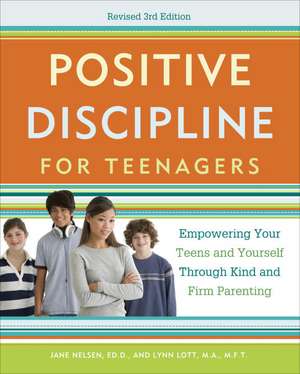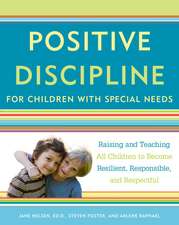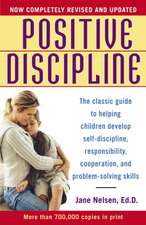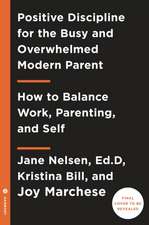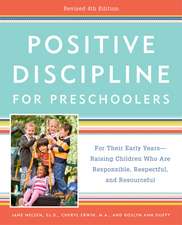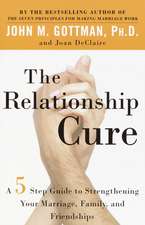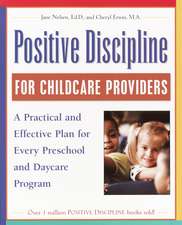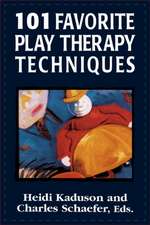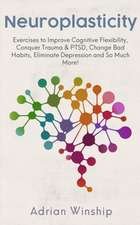Positive Discipline for Teenagers
Autor Jane Nelsenen Limba Engleză Paperback – 14 aug 2012
Adolescence can be a time of great stress and turmoil—not only for kids going through it, but for their parents as well. It’s normal for teens to explore a new sense of freedom and to redefine the ways in which they relate to their parents, and that process can sometimes leave parents feeling powerless, alienated, or excluded from their children’s lives. These effects can be magnified even further in this modern age of social networks, cell phones, and constant digital distraction.
This newly revised and updated edition of Positive Discipline for Teenagers shows parents how to build stronger bridges of communication with their children, break the destructive cycles of guilt and blame that occur in parent-teen power struggles, and work toward greater mutual respect with their adolescents. At the core of the Positive Discipline approach is the understanding that teens still need their parents, just in different ways--and by better understanding who their teens really are, parents can learn to encourage both their teens and themselves, and instill good judgment without being judgmental. The methods in this book work to build vital social and life skills through encouragement and empowerment--not punishment. Truly effective parenting is about connection before correction.
Over the years, millions of parents have come to trust Jane Nelsen’s classic Positive Discipline series for its consistent, commonsense approach to raising happy, responsible kids. This new edition is filled with proven, effective methods for coping with such parenting challenges as:
-Fostering truly honest discussions with your teen
-Helping your teen handle the online world
-Turning mistakes into opportunities
-Keeping your sanity while raising your teen—and making sure your own teenage issues aren’t weighing you down
-Teaching your teen how to pursue the goal that make them happy…and a few that make you happy too (like chores)
-Making sure you’re on your teen’s side, and that they know that
-Avoiding the pitfalls of excessive control and excessive permissiveness
Preț: 75.55 lei
Preț vechi: 89.47 lei
-16% Nou
Puncte Express: 113
Preț estimativ în valută:
14.46€ • 15.13$ • 11.96£
14.46€ • 15.13$ • 11.96£
Carte disponibilă
Livrare economică 15-22 martie
Livrare express 01-07 martie pentru 38.56 lei
Preluare comenzi: 021 569.72.76
Specificații
ISBN-13: 9780770436551
ISBN-10: 0770436552
Pagini: 261
Ilustrații: Illustrations
Dimensiuni: 188 x 234 x 23 mm
Greutate: 0.36 kg
Ediția:Revised
Editura: Three Rivers Press (CA)
ISBN-10: 0770436552
Pagini: 261
Ilustrații: Illustrations
Dimensiuni: 188 x 234 x 23 mm
Greutate: 0.36 kg
Ediția:Revised
Editura: Three Rivers Press (CA)
Cuprins
Introduction 1
Chapter 1 How Do You Know When Your Child Becomes a
Teen?
Chapter 2 Whose Side Are You On?
Chapter 3 What Is Your Parenting Style?
Chapter 4 How Can Mistakes Be Wonderful Opportunities to
Learn?
Chapter 5 How Do You Motivate Teens?
Chapter 6 Does Your Teenager Hear Anything You Say?
Chapter 7 Do Family Meetings Work with Teenagers?
Chapter 8 How Can You Spend Special Time with Your Teen?
Chapter 9 Are You Enabling or Empowering Your Teen?
Chapter 10 Are You Teaching Life Skills?
Chapter 11 How Wired Are Your Teens?
Chapter 12 Why Do They Act Like That?
Chapter 13 What Do You Do About Scary Behavior?
Chapter 14 Are Your Unresolved Teen Issues Getting in Your
Way?
Conclusion
Acknowledgments
Index
Chapter 1 How Do You Know When Your Child Becomes a
Teen?
Chapter 2 Whose Side Are You On?
Chapter 3 What Is Your Parenting Style?
Chapter 4 How Can Mistakes Be Wonderful Opportunities to
Learn?
Chapter 5 How Do You Motivate Teens?
Chapter 6 Does Your Teenager Hear Anything You Say?
Chapter 7 Do Family Meetings Work with Teenagers?
Chapter 8 How Can You Spend Special Time with Your Teen?
Chapter 9 Are You Enabling or Empowering Your Teen?
Chapter 10 Are You Teaching Life Skills?
Chapter 11 How Wired Are Your Teens?
Chapter 12 Why Do They Act Like That?
Chapter 13 What Do You Do About Scary Behavior?
Chapter 14 Are Your Unresolved Teen Issues Getting in Your
Way?
Conclusion
Acknowledgments
Index
Notă biografică
JANE NELSEN, Ed.D, coauthor of the bestselling Positive Discipline series, is a licensed marriage, family, and child therapist and an internationally known speaker.
LYNN LOTT, M.A., M.F.T., is a therapist and author of more than 18 books and manuals including four in the Positive Discipline series.
LYNN LOTT, M.A., M.F.T., is a therapist and author of more than 18 books and manuals including four in the Positive Discipline series.
Extras
How Do You Know When Your Child Becomes a Teen?
When Your Child No Longer Thinks You Hang the Stars
When Sally became a teenager, her mother thought Sally had become a different person. She dressed differently, had different friends, became a rock fan, and started playing the guitar. Underneath, she was still Sally, but now she had taken on a new role: Sally “the rocker.” A friend asked Sally’s mother, “When Sally was little, was she interested in superheroes? Did she ask you to sew a ‘W’ on her leotard so she could pretend to be Wonder Woman? Did you think it was cute?” Mom smiled as she remembered how cute she thought Sally was at this stage of her life. Her friend continued, “Could you think of her that way now? Imagine that she’s put on the suit of a rocker. That’s what is going on; she’s trying on an identity, but the identity is not who Sally really is.”
It may help to remember how different your personality is now from the way you were as a teen. Even though living with your adolescent child may seem to last forever, adolescence is just a brief part of the growing process. It is by no means the final destination.
The Dream Teen and the Normal Teen
In our workshops on parenting teenagers, we challenge preconceived notions about teens through an activity called “Draw a Teen” (from the manual: Teaching Parenting the Positive Discipline Way by Lynn Lott and Jane Nelsen, 6th edition, 2008). We form two groups. One group is asked to draw a “normal” teen—how most parents see their teens. We invite them to exaggerate. The composite teen is self-centered, listens to loud music, defies authority, prefers friends to family, has a messy room decorated with posters, values cars and an independent lifestyle, conforms to the clothing styles of peers (no matter how gross), is wearing earphones and is playing video games, smokes, and drinks alcohol. Comments from the group include:
“Well, this is an exaggeration. All teens aren’t like this.”
“But it sure does depict the rebelliousness because most of them are a lot like this.”
“It helps to be reminded that my teen would not be normal if he cleaned his room.”
“Come to think about it, I was like that once.”
This last comment was a nice reminder to the group that we all continue to grow and change beyond adolescence.
The other group is asked to draw a “dream” teen, or how most parents think they want their teens to be. This composite teen is voted prom queen or king, keeps agreements (“I promise to be there on time, as always”), volunteers to help, loves to talk to parents (“Let me tell you everything about my life”), eats only healthy food, doesn’t watch television, is very athletic, earns two scholarships (one athletic and one academic), scores high on the SATs, lines up a summer job by January, supplies his or her own money for hair or makeup and saves the rest for college and a car, respects everyone (including siblings), is respectfully assertive, doesn’t waste time on video games, and is an A student. Comments from the group include:
“A teen like this wouldn’t have any friends. No one could stand him or her.”
“I have friends who have a teen like this and I can’t stand her.”
“My teen is like this, although she seems pretty stressed most of the time.”
“I can see that I expect my teen to be perfect, even though I’m not.”
“I know a few teens like this and I think they’re terrific.”
Parents often see the dream teen as the “good kid.” You may not have thought about this, but these teens may have sold out to become pleasers and approval junkies. Their parents use them as the standard and say to siblings, “Why can’t you be more like your brother or sister? At least I have one that doesn’t give me any trouble.” The “good kid” may feel significant only if he or she is getting this kind of praise. Many teens like this fall apart when they make their first big mistake. Some cannot handle the competition when they get to college and discover they are not the only special student. Unable to handle this pressure, some even commit suicide because they don’t think they can stay on top. Others start their individuation very late, sometimes wasting their freshman year in college partying instead of studying now that they are not feeling pressured by their parents.
What all teens are trying to figure out is, “Who am I, and am I good enough?” That journey can look very different from the outside, depending on the teen. Don’t be fooled by appearances. It’s pretty tough to go through adolescence without some insecurity. Keep in mind that if you fantasize about having a dream teen, that kid might be struggling with issues of perfectionism.
Your Feelings Let You Know When Your Child Has Become a Teen
Most dramatic changes with your kids are accompanied by a feeling response from you. Think how excited you were when your kids were potty trained. Remember how you felt when your kid said “NO” to everything you asked. Flash back to your feelings when your kids started school or had their first overnight at a friend’s house. Now think about some of the feelings you’ve had as your kids have evolved into adolescence. Can you match the shock and/or stress experienced by the following parents?
Herb recalled the day he inadvertently discovered his eleven-year-old daughter, Kim, had sent 210 text messages in less than a day to a boy in her class. Most of the texts referred to how much they liked each other and that they wanted to kiss each other. Herb’s other daughter, fifteen-year-old Macy, had no interest in boys or even texting, so it took him by surprise to realize that his eleven-year-old daughter had become a teen.
Maxine took her stepson shopping for a new winter jacket. When the sales clerk put the jacket in a shopping bag, her stepson walked away and started heading out of the store, leaving the bag on the counter. Maxine grabbed the bag, irritated that her stepson was acting so unappreciative. When she met him at the car, she asked him what was going on. He said, “I wasn’t going to have anyone see me carrying a shopping bag through the mall. That’s lame.” Maxine didn’t know whether she wanted to hug him or shoot him.
Sandi remembered the shock she felt when her nephew, who never noticed if his socks matched or his hair was combed, showed up in pants hanging below his waist, tennis shoes without laces, and a head full of mousse. He had mastered the latest “teen” look.
Pete told his friend, “I don’t know what’s going on with my thirteen- year-old son, Trevor. One minute he’s my best friend and the next he’s yelling at me and treating me like the enemy. I’m starting to come down hard on him so he doesn’t think he can get away with that lousy behavior. I can’t remember when I’ve felt so angry.” Pete’s friend couldn’t help laughing. “Pete,” he said, “welcome to the world of teenagers. You’ve been anointed.”
Anointment to Teen Parenting Can Be Stressful
Stress is the space between your thoughts of how life should be and how life really is. This definition of stress (although different from what you may have heard) can be very helpful. Since stress is created by your thoughts, you can feel less stressed by becoming aware of the thoughts and looking either for ways to change how life is or what you think it should be. This method can be done without deep breathing (though it won’t hurt you to take a few deep breaths) or jogging (though we encourage exercise of all kinds) or taking pills or having a drink (really). In the following activity, we’ll show you how easy it can be to reduce stress.
Grab a sheet of paper. At the top of the paper, start by writing down your view of how you think it should be with your teen. Now write down how it is across the bottom of the paper. Look at the space between the top and the bottom of the paper, and in large letters that fill all the space, write the word “STRESS.” Stress is represented by the space between how life should be (according to you) and how life is.
At this point you can see why you’re feeling so stressed—there’s probably a big gap between the two. Now think about what you do when you’re stressed. Jot it down on your paper somewhere in the middle of the sheet. What you’re writing down are your coping behaviors for dealing with stress. If you look closely, your coping behaviors could be increasing your stress.
Here’s the tricky part. It’s called “paper folding.” Your job is to fold the bottom of the paper to meet the top of the paper so that both lines you wrote are now next to each other. (Parents, you may need to ask your teens to do this for you.) As you look at the two lines close together without the stress in between, what are you thinking, feeling, and deciding?
Aimee tried this activity. At the top she wrote, “It drives me crazy when my son procrastinates and waits until the last minute to get his homework done. I hate nagging him all the time.”
At the bottom she wrote, “No matter what I do, he just gets angry and procrastinates more. The frustrating thing is that he usually gets his assignments done, but he creates so much stress for himself and for me.”
Aimee shared that the big gap between the top of the paper and the bottom was a good representation of her stress. The way she handled the stress was to feel angry and obsess about, “Why can’t he just do what he is supposed to do?” Then she interrupts whatever he is doing and bugs him to get his assignments done. She threatens him with loss of privileges and feels angry when it doesn’t work. Then she thinks of herself as a failure as a mom because she can’t change him.
When she folded the paper so the lines were next to each other without the big gap, she said, “What a waste. All my anger and nagging doesn’t change a thing. I wonder what would happen if I just acknowledged him for pulling his homework out of the hat at the last minute? Would that just reinforce his procrastination? Well, what I’m doing isn’t changing anything. I can at least give up my stress. And it would be fun to watch the look on his face when I compliment him instead of nagging him.”
This stress activity has helped many parents gain awareness that eliminated (or greatly reduced) their stress. You can also reduce your stress when you understand that who your teens are today is not who they will be forever.
Who They Are Today Is Not Who They Will Be Forever
When Mary was a teenager, her mother constantly nagged her about leaving her dirty dishes in her room or in the sink. Now Mary nags her husband about leaving his dirty dishes around the house or in the sink. Brian seemed self-centered and selfish as a teen. As an adult he is a social worker who advocates for people in need.
Think of yourself as a teenager. In what ways are you different as an adult than you were then? Are you more responsible? Do you have more purpose and motivation in life? Are you less selfish? Are you more considerate of others? You might find it helpful to make a list of the dramatic ways you have changed since you were a teenager.
Although it may seem otherwise, teens have not grown up yet. Their behavior is only temporary. Teens want to explore how they are different from their families, how they feel and what they think about things, and what their own values are. This process of separation from the family is called “individuation.”
Teenage individuation can start as early as ten or eleven and as late as eighteen or nineteen. Some people never individuate (other than changing physically), or wait until adulthood to make the big steps described in the following characteristics of individuation, which are discussed in more detail after the list.
CHARACTERISTICS OF INDIVIDUATION
Adolescents have a need to find out who they are.
Individuation often looks like rebellion because teens are testing family values.
Adolescents go through huge physical and emotional changes.
Peer relationships take precedence over family relationships.
Teens explore and exercise personal power and autonomy.
Teens have a great need for privacy from their parents.
Parents become an embarrassment to their teens.
Teens see themselves as omnipotent and all knowing.
Keep in mind that these characteristics occur on a continuum from hardly at all to almost all the time. Teenage development can look very different from teen to teen.
Adolescents Have a Need to Find Out Who They Are
You know that your children are individuating when they start keeping secrets from you. Do you remember your own teen secrets? When we ask parents to do an activity called “Teen Secrets” (What did you do as a teen that you didn’t want your parents to know about?), there is a lot of laughter as they share their stories about sneaking out at night, experimenting with drugs and alcohol, sex in the backseats of cars, tipping over cows, and pranks that would warrant jail sentences today. These parents are CEOs of companies, teachers, principals, mechanics, doctors, plumbers, fathers, and mothers who are scared that their children are doing what they did as teens.
Individuation often Looks Like Rebellion
Although most parents worry when their teenagers rebel, it would be more appropriate to worry if they didn’t. Teenagers must begin their separation from their families, and rebellion gives them the ability to do this. At first, teens may rebel by challenging what is important to their families (family values) or zeroing in on what their parents want and then doing exactly the opposite. Later, they may rebel in other ways—but at first individuation is primarily a reaction against their parents, and doing the opposite is the simplest, most natural way of being different. If teens are not allowed to rebel, they may do it in their twenties, thirties, or fifties. Teens who don’t rebel (individuate) may become approval junkies—afraid to take risks or to feel comfortable with who they are.
When teens can go through their process of individuation in a supportive atmosphere (see Chapter 9), they are more likely to readopt family values in their twenties. The more they encounter disrespectful judgment, punishment, and control, the more likely they will get “stuck” in their individuation process, and the less likely it is that they will come back to family values.
When Your Child No Longer Thinks You Hang the Stars
When Sally became a teenager, her mother thought Sally had become a different person. She dressed differently, had different friends, became a rock fan, and started playing the guitar. Underneath, she was still Sally, but now she had taken on a new role: Sally “the rocker.” A friend asked Sally’s mother, “When Sally was little, was she interested in superheroes? Did she ask you to sew a ‘W’ on her leotard so she could pretend to be Wonder Woman? Did you think it was cute?” Mom smiled as she remembered how cute she thought Sally was at this stage of her life. Her friend continued, “Could you think of her that way now? Imagine that she’s put on the suit of a rocker. That’s what is going on; she’s trying on an identity, but the identity is not who Sally really is.”
It may help to remember how different your personality is now from the way you were as a teen. Even though living with your adolescent child may seem to last forever, adolescence is just a brief part of the growing process. It is by no means the final destination.
The Dream Teen and the Normal Teen
In our workshops on parenting teenagers, we challenge preconceived notions about teens through an activity called “Draw a Teen” (from the manual: Teaching Parenting the Positive Discipline Way by Lynn Lott and Jane Nelsen, 6th edition, 2008). We form two groups. One group is asked to draw a “normal” teen—how most parents see their teens. We invite them to exaggerate. The composite teen is self-centered, listens to loud music, defies authority, prefers friends to family, has a messy room decorated with posters, values cars and an independent lifestyle, conforms to the clothing styles of peers (no matter how gross), is wearing earphones and is playing video games, smokes, and drinks alcohol. Comments from the group include:
“Well, this is an exaggeration. All teens aren’t like this.”
“But it sure does depict the rebelliousness because most of them are a lot like this.”
“It helps to be reminded that my teen would not be normal if he cleaned his room.”
“Come to think about it, I was like that once.”
This last comment was a nice reminder to the group that we all continue to grow and change beyond adolescence.
The other group is asked to draw a “dream” teen, or how most parents think they want their teens to be. This composite teen is voted prom queen or king, keeps agreements (“I promise to be there on time, as always”), volunteers to help, loves to talk to parents (“Let me tell you everything about my life”), eats only healthy food, doesn’t watch television, is very athletic, earns two scholarships (one athletic and one academic), scores high on the SATs, lines up a summer job by January, supplies his or her own money for hair or makeup and saves the rest for college and a car, respects everyone (including siblings), is respectfully assertive, doesn’t waste time on video games, and is an A student. Comments from the group include:
“A teen like this wouldn’t have any friends. No one could stand him or her.”
“I have friends who have a teen like this and I can’t stand her.”
“My teen is like this, although she seems pretty stressed most of the time.”
“I can see that I expect my teen to be perfect, even though I’m not.”
“I know a few teens like this and I think they’re terrific.”
Parents often see the dream teen as the “good kid.” You may not have thought about this, but these teens may have sold out to become pleasers and approval junkies. Their parents use them as the standard and say to siblings, “Why can’t you be more like your brother or sister? At least I have one that doesn’t give me any trouble.” The “good kid” may feel significant only if he or she is getting this kind of praise. Many teens like this fall apart when they make their first big mistake. Some cannot handle the competition when they get to college and discover they are not the only special student. Unable to handle this pressure, some even commit suicide because they don’t think they can stay on top. Others start their individuation very late, sometimes wasting their freshman year in college partying instead of studying now that they are not feeling pressured by their parents.
What all teens are trying to figure out is, “Who am I, and am I good enough?” That journey can look very different from the outside, depending on the teen. Don’t be fooled by appearances. It’s pretty tough to go through adolescence without some insecurity. Keep in mind that if you fantasize about having a dream teen, that kid might be struggling with issues of perfectionism.
Your Feelings Let You Know When Your Child Has Become a Teen
Most dramatic changes with your kids are accompanied by a feeling response from you. Think how excited you were when your kids were potty trained. Remember how you felt when your kid said “NO” to everything you asked. Flash back to your feelings when your kids started school or had their first overnight at a friend’s house. Now think about some of the feelings you’ve had as your kids have evolved into adolescence. Can you match the shock and/or stress experienced by the following parents?
Herb recalled the day he inadvertently discovered his eleven-year-old daughter, Kim, had sent 210 text messages in less than a day to a boy in her class. Most of the texts referred to how much they liked each other and that they wanted to kiss each other. Herb’s other daughter, fifteen-year-old Macy, had no interest in boys or even texting, so it took him by surprise to realize that his eleven-year-old daughter had become a teen.
Maxine took her stepson shopping for a new winter jacket. When the sales clerk put the jacket in a shopping bag, her stepson walked away and started heading out of the store, leaving the bag on the counter. Maxine grabbed the bag, irritated that her stepson was acting so unappreciative. When she met him at the car, she asked him what was going on. He said, “I wasn’t going to have anyone see me carrying a shopping bag through the mall. That’s lame.” Maxine didn’t know whether she wanted to hug him or shoot him.
Sandi remembered the shock she felt when her nephew, who never noticed if his socks matched or his hair was combed, showed up in pants hanging below his waist, tennis shoes without laces, and a head full of mousse. He had mastered the latest “teen” look.
Pete told his friend, “I don’t know what’s going on with my thirteen- year-old son, Trevor. One minute he’s my best friend and the next he’s yelling at me and treating me like the enemy. I’m starting to come down hard on him so he doesn’t think he can get away with that lousy behavior. I can’t remember when I’ve felt so angry.” Pete’s friend couldn’t help laughing. “Pete,” he said, “welcome to the world of teenagers. You’ve been anointed.”
Anointment to Teen Parenting Can Be Stressful
Stress is the space between your thoughts of how life should be and how life really is. This definition of stress (although different from what you may have heard) can be very helpful. Since stress is created by your thoughts, you can feel less stressed by becoming aware of the thoughts and looking either for ways to change how life is or what you think it should be. This method can be done without deep breathing (though it won’t hurt you to take a few deep breaths) or jogging (though we encourage exercise of all kinds) or taking pills or having a drink (really). In the following activity, we’ll show you how easy it can be to reduce stress.
Grab a sheet of paper. At the top of the paper, start by writing down your view of how you think it should be with your teen. Now write down how it is across the bottom of the paper. Look at the space between the top and the bottom of the paper, and in large letters that fill all the space, write the word “STRESS.” Stress is represented by the space between how life should be (according to you) and how life is.
At this point you can see why you’re feeling so stressed—there’s probably a big gap between the two. Now think about what you do when you’re stressed. Jot it down on your paper somewhere in the middle of the sheet. What you’re writing down are your coping behaviors for dealing with stress. If you look closely, your coping behaviors could be increasing your stress.
Here’s the tricky part. It’s called “paper folding.” Your job is to fold the bottom of the paper to meet the top of the paper so that both lines you wrote are now next to each other. (Parents, you may need to ask your teens to do this for you.) As you look at the two lines close together without the stress in between, what are you thinking, feeling, and deciding?
Aimee tried this activity. At the top she wrote, “It drives me crazy when my son procrastinates and waits until the last minute to get his homework done. I hate nagging him all the time.”
At the bottom she wrote, “No matter what I do, he just gets angry and procrastinates more. The frustrating thing is that he usually gets his assignments done, but he creates so much stress for himself and for me.”
Aimee shared that the big gap between the top of the paper and the bottom was a good representation of her stress. The way she handled the stress was to feel angry and obsess about, “Why can’t he just do what he is supposed to do?” Then she interrupts whatever he is doing and bugs him to get his assignments done. She threatens him with loss of privileges and feels angry when it doesn’t work. Then she thinks of herself as a failure as a mom because she can’t change him.
When she folded the paper so the lines were next to each other without the big gap, she said, “What a waste. All my anger and nagging doesn’t change a thing. I wonder what would happen if I just acknowledged him for pulling his homework out of the hat at the last minute? Would that just reinforce his procrastination? Well, what I’m doing isn’t changing anything. I can at least give up my stress. And it would be fun to watch the look on his face when I compliment him instead of nagging him.”
This stress activity has helped many parents gain awareness that eliminated (or greatly reduced) their stress. You can also reduce your stress when you understand that who your teens are today is not who they will be forever.
Who They Are Today Is Not Who They Will Be Forever
When Mary was a teenager, her mother constantly nagged her about leaving her dirty dishes in her room or in the sink. Now Mary nags her husband about leaving his dirty dishes around the house or in the sink. Brian seemed self-centered and selfish as a teen. As an adult he is a social worker who advocates for people in need.
Think of yourself as a teenager. In what ways are you different as an adult than you were then? Are you more responsible? Do you have more purpose and motivation in life? Are you less selfish? Are you more considerate of others? You might find it helpful to make a list of the dramatic ways you have changed since you were a teenager.
Although it may seem otherwise, teens have not grown up yet. Their behavior is only temporary. Teens want to explore how they are different from their families, how they feel and what they think about things, and what their own values are. This process of separation from the family is called “individuation.”
Teenage individuation can start as early as ten or eleven and as late as eighteen or nineteen. Some people never individuate (other than changing physically), or wait until adulthood to make the big steps described in the following characteristics of individuation, which are discussed in more detail after the list.
CHARACTERISTICS OF INDIVIDUATION
Adolescents have a need to find out who they are.
Individuation often looks like rebellion because teens are testing family values.
Adolescents go through huge physical and emotional changes.
Peer relationships take precedence over family relationships.
Teens explore and exercise personal power and autonomy.
Teens have a great need for privacy from their parents.
Parents become an embarrassment to their teens.
Teens see themselves as omnipotent and all knowing.
Keep in mind that these characteristics occur on a continuum from hardly at all to almost all the time. Teenage development can look very different from teen to teen.
Adolescents Have a Need to Find Out Who They Are
You know that your children are individuating when they start keeping secrets from you. Do you remember your own teen secrets? When we ask parents to do an activity called “Teen Secrets” (What did you do as a teen that you didn’t want your parents to know about?), there is a lot of laughter as they share their stories about sneaking out at night, experimenting with drugs and alcohol, sex in the backseats of cars, tipping over cows, and pranks that would warrant jail sentences today. These parents are CEOs of companies, teachers, principals, mechanics, doctors, plumbers, fathers, and mothers who are scared that their children are doing what they did as teens.
Individuation often Looks Like Rebellion
Although most parents worry when their teenagers rebel, it would be more appropriate to worry if they didn’t. Teenagers must begin their separation from their families, and rebellion gives them the ability to do this. At first, teens may rebel by challenging what is important to their families (family values) or zeroing in on what their parents want and then doing exactly the opposite. Later, they may rebel in other ways—but at first individuation is primarily a reaction against their parents, and doing the opposite is the simplest, most natural way of being different. If teens are not allowed to rebel, they may do it in their twenties, thirties, or fifties. Teens who don’t rebel (individuate) may become approval junkies—afraid to take risks or to feel comfortable with who they are.
When teens can go through their process of individuation in a supportive atmosphere (see Chapter 9), they are more likely to readopt family values in their twenties. The more they encounter disrespectful judgment, punishment, and control, the more likely they will get “stuck” in their individuation process, and the less likely it is that they will come back to family values.
Descriere
This newly revised and updated edition of shows parents how to build stronger bridges of communication with their children, break the destructive cycles of guilt and blame that occur in parent-teen power struggles, and work toward greater mutual respect with their adolescents.
